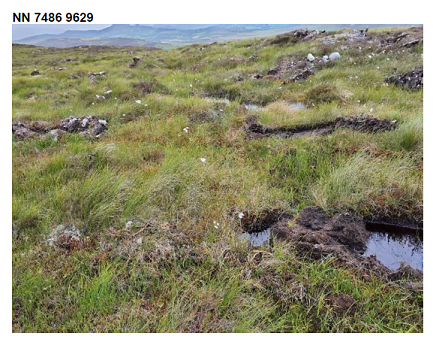
I have not visited Far Ralia, the land in the Cairngorms National Park Abrdn’s Property Income Trust (APIT) bought for £7.5m three years ago and has now put on the market for £12m, since January. I have, however, recently obtained a copy of an inspection Scottish Forestry (SF) conducted in June through a freedom of information request. (SF’s very helpful staff who deal with such requests provided the report well within the statutory deadline). The findings of the Inspection Report, like those I obtained for BrewDog’s Lost Forest (see here) and Muckrach (see here), provides damning evidence of the failure of Scotland forestry grants system. It shows that a high proportion of the c1 million trees planted to date are in breach of Scottish Forestry’s grant conditions, contrary to what was promised and have been damaging to the natural environment.
The wrong trees in the wrong place
Abrdn engaged AKRE trees, managed by Renwick Drysdale a member of the family of the previous owners (see here), to plan and undertake the tree planting and peatland restoration at Far Ralia. A year ago Jason Baggaley, APIT’s fund manager, wrote a blog for Scottish Land and Estates (see here) in which he made a number of claims about the quality of the “nature restoration” project including:
“Akre has undertaken seed collection from the site to ensure the provenance and genetic integrity of the woodland. The trees from these seeds are being grown in the firm’s carbon-negative nursery in Fife, before returning them to the site over the next few years”
That claim about “seed collection from the site” directly contradicted Abrdn’s justification for being awarded a £2.5m forestry grant to plant trees, an alleged lack of seed source that would have enabled woodland to regenerate naturally! The Inspection Report now shows that AKRE didn’t even collect seeds from neighbouring sites in the same seed zone:

Scottish Forestry’s guidance on seed source is designed to protect the genetic diversity of native woodland and was incorporated into its contract with Abrdn: “Should 201 not be available, neighbouring seed zones 202, 102 east will be used” as per the guidance and if not, “alternative seed zones will be discussed with Scottish Forestry.” It appears that AKRE, acting on behalf of Abrdn, failed to do this and as a result of the c1 million trees e planted to date c160,000 are from the wong seed zone. Unfortunately, the Inspection Report fails to state which tree spcies and which areas have been planted with treee from the wrong source but the risk to the genetic integrity of the Caledonian Pine woods naturally regenerating just over the hill in Glens Tromie and Feshie is likely to be significant.
The inspectors also spotted a number of other wrong trees in the wrong place on their visit:

The thoroughness of the inspectors is to be commended although their report does not attempt to estimate how many of the saplings were below the expected size or how many oak have been planted at high elevations and are likely to die as a consequence. As for Sycamore, while naturalised in Scotland, these were not part of the woodland creation project. An excellent photo shows how they have been imported into Far Ralia by AKRE’s planting:
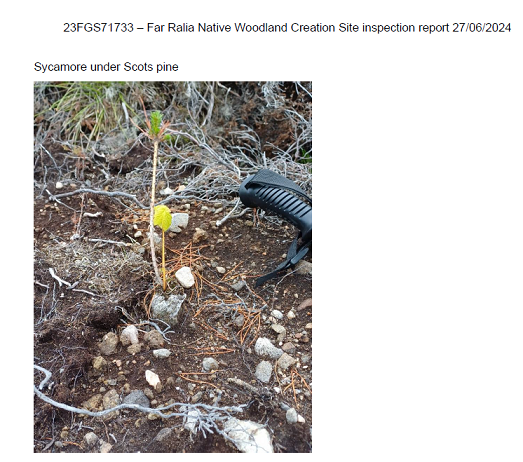
The reference to these trees coming “from the nursery” appears to be a reference to AKRE’s tree nursery in Fife, partly paid for by the public and opened by the Scottish Minister responsible for the Forestry Grants system (see here).
The rogue sycamore helps illustrate a wider issue with the forestry grants system, how supporting the planting trees in nurseries can help spread not just unwanted seeds but tree diseases etc. Even if AKRE had collected seed from the right seed zones as it had promised, taking these seeds down to Fife to grow before returning them to the National Park was never a sensible idea.
While Scottish Forestry took a fairly lax approach to the saplings were sourced from the wrong seed zone at BrewDog’s Lost Forest (see here) at Far Ralia the Inspectors have recommended far tougher action to address the wrong tree being planted in the wrong place:

That’s 160,000 trees that will need to be replaced, a huge exercise in itself, but along with that checks on the remaining 840,000 trees that have been planted to date to see if the soil “plugs” have been contaminated with sycamore.
Whatever that costs it should have an impact on Abrdn’s £12m asking price for the land. It also further undermines Abrdn, AKRE and the Natural History Museum (NHM)’s claims (see here), repeated in the sales brochure, that this woodland creation project will increase the biodiversity intactness index (BII) of the site from 52% to 95%. If the NHM’s BII methodology is based on science, the biodiversity intactness of Far Ralia should now have reduced to well under 50% and that again should affect the asking price.
The destruction of peaty soils

The Inspection Report only contains one photo of planting on deep peat (top photo) but highlights the impact of ATVs tracking across peaty soils and a significant number of areas where trees have been planted in deep peat and flushes:
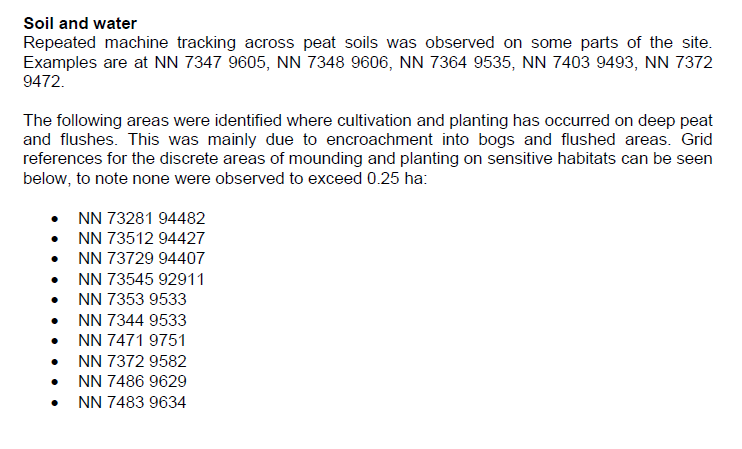 Abrdn’s contract with Scottish Forestry clearly stated “No areas of deep peat (peat >50cm) will be invert mounded or hinge mounded, neither will GWDTEs [ground water dependant terrestrial ecoystems]”
Abrdn’s contract with Scottish Forestry clearly stated “No areas of deep peat (peat >50cm) will be invert mounded or hinge mounded, neither will GWDTEs [ground water dependant terrestrial ecoystems]”

While AKRE claimed that most of the planting would be by inverted mounding (where a dollop of vegetation and soil is turned upside down leaving not a mound but a flat surface) or by hinge mounding (where a flap of soil and vegetation is hinged over to create a mound and hole), the photos from SF’s inspection show much of the ground has been scraped not mounded. The inspectors appears to have rightly decided to treat this the same as mounding.
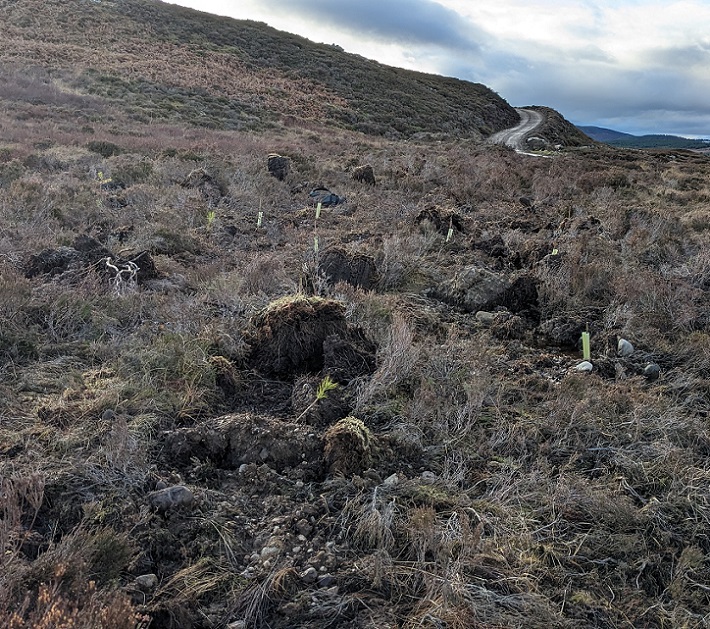
Hinge mounding takes less time than inverted mounding and is therefore cheaper but scraping is cheaper still. Scraping appears to reduce the likelihood of trees surviving because of the instability of the scraped soil (as illustrated by the keeled sapling in the photo above) but more significantly exposes larger areas of soil to the air, releasing more carbon into the atmosphere, and alters the flow of water over the land.
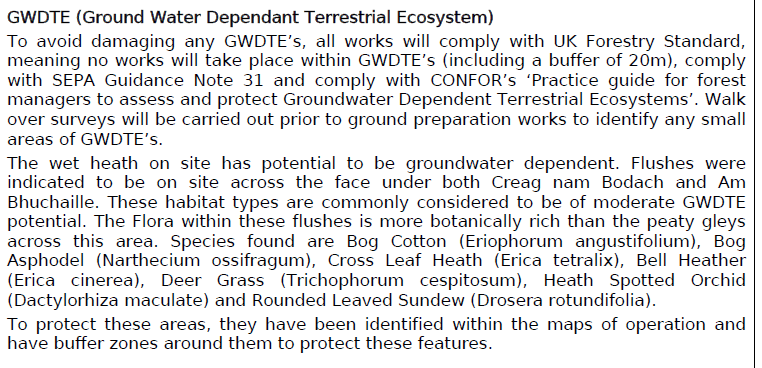
In his blog for Scottish Land and Estates Jason Baggaley also claimed:
“As part of the project, we will also restore 150 hectares of degraded peatland. Peatlands store vast quantities of carbon, an estimated 3.2 billion tonnes in the UK alone”.
Unfortunately to date, whatever the intentions, all Abrdn has has achieved is to destroy peat releasing carbon into the atmosphere.
AKRE, in their case study (see here) of the whole project “estimated that Far Ralia will deliver up to 195,000 tonnes of claimable carbon to 2060.” That included the peatland restoration which it claims to have agreed in principle with the Cairngorms National Park Authority (CNPA) but has not so far been actioned:
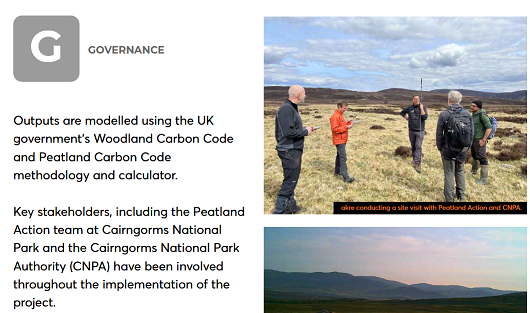
Paying landowners to restore peat on the one hand and to destroy it on the other by planting trees on peat less than 50cm deep makes no rational sense from a carbon off-setting policy perspective. But while chasing the money, AKRE or Abrdn could have at least ensured their contractors respected the existing rules and did not plant on flushes and peat more than 50cm deep. They don’t appear to have bothered.
Thankfully the SF Inspectors have come down heavily on those breaches of the rules:

The Inspection Report does not say how many more of the trees, in addition to the 160,000 from the wrong seed source, will need to be replaced or how many mounds and scrapes will have to be restored. Given the quality of their work to date, it is also reasonable to ask whether AKRE and Abrdn can be trusted to do this? Certainly doing so by the end of October, as required in the Inspection Report, will present both with a major challenge.
All this should have further implications for Abrdn’s £12m asking price for Far Ralia.
SF’s target culture
Given the fact that at this early stage something like 200,000 or a fifth of all the trees that have been planted (160k from the wrong seed zone, the oak and the trees planted in bog and flushes) at Far Ralia may need to be replaced, the summary findings at the start of SF’s inspection report make for surprising reading:
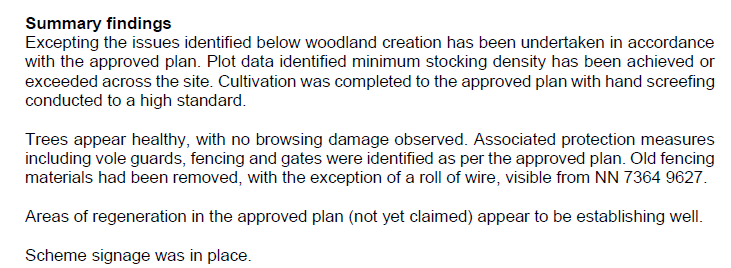
The explanation for this complacency, which was also displayed in the inspection report for the Muckrach planting (see here), is that SF’s primary and overriding concern is to meet the Scottish Government’s tree planting targets whatever the cost to the natural environment. As long as landowners and their agents plant sufficient trees to meet “minimum stocking density” nothing else really matters. Under forestry grants contracts the landowner has to meet the financial costs of replacing any trees and as long as this happens SF can report to Scottish Ministers that targets have been met. The destruction that is being caused in the process, in places like the Lost Forest, Muckrach and Far Ralia, is still of no account.
A Complicit National Park Authority
The Cairngorms National Park Authority (CNPA) Planning Committee, which consists of all board members, were asked on Friday to approve the retrospective planning application to widen the road up to Far Ralia which I considered in May (see here) and did so. After writing that post on 2nd May I tried to submit an objection to the application on the planning portal but this was rejected because the CNPA’s standing orders only allow the public to comment within the statutory minimum period of 28 days. As I pointed out in subsequent correspondence with the CNPA’s head of planning, Gavin Miles:
“In my view it is absolutely outrageous that the CNPA should have published a Screening Opinion yesterday, saying no EIA is required, and allow no time for comment on this. As you should be aware the area is one of the most important for XXXXX in Scotland but there is not even a mention of this in the EIA. Now the track works and changes to the ecology of the area may or may not have implications for the XXXXXXXs but not to consider this is an abdication of the precautionary principle and basic principles of democracy and transparency.”
I went on to say:
I know from previous experience that the CNPA will not allow people to speak at the Planning Committee unless objections have been submitted in time but I would ask that I be allowed to do so – by zoom if the Committee goes ahead in June as I am likely to be away on that date.”
That request was initially refused but, in a farcical turn of events, I was then accidentally invited to speak before that invitation was withdrawn!
CNPA officers will, however, consider email communications raising “new” material poiints about planning applications to those in the know. There is, however, a catch, which is reflected in the wording of the Committee Report (see here):
“No representations were received within the [minumum] statutory period for representations. One representation was received after the period for written representations and will be reported during the planning officer’s presentation to the committee”.
CNPA officers don’t incorporate points made after the minimum statutory period for representations in Committee reports- despite having had 10 weeks to do so in this case – but officers pick and choose what to report verbally at the meeting. For the written record, the points I made were:
1) The Supporting Statement from the applicants agent is unfit for purpose* (see below)
2) Some of the information in the documentation is clearly incorrect, eg the location of the borrow pits and the images supplied do not reflect the situation on the ground
3) Much of the restoration of the borrow pits has been of poor quality and in some cases the vegetation that has been used is clearly inappropriate
4) The design of the road is clearly unfit for purpose, with the new surface already eroding badly
5) The new sections of bank along the road and new culverts have not been mentioned in the application (or marked on the location maps) nor their impacts considered and there are no restoration proposals for these aspects of the development
6) There is no mention of restoring a central vegetated strip down the road, which the CNPA has in the past required as a matter of good practice.
The only points that were (partially) covered by Gavin Miles, the head of planning, at the meeting were 5 and 6. Thankfully officers are now going to require a vegetated strip down the centre of the road, which should help reduce erosion – a small mercy!.
The main emphasis of Mr Miles at the meeting (the video is available for viewing) is that the principle of development had been established and therefore, by implication, that Board Members had little option but to accept this application. That view was embedded in the Committee Report:
“Notwithstanding the fact that the works were commenced without the requisite grant of planning permission, the proposal is to upgrade a pre-existing track and as such the principle of the track at this location is established and acceptable in principle, subject to detailed consideration of design and proposed mitigation measures.”
The assumption of planning staff here is that once an upland track is in place it is acceptable in principle. In my view this is completely wrong and has serious implications for the statutory aims of the National Park. The upper part of the existing Far Ralia road was cut through deep peat (see here) and the CNPA should, as I have argued previously, have been using its powers and influence to have it removed. Had the National Trust for Scotland and Wildland Ltd worked on this “principle”, they would never have removed any hill roads on their land.
The claim that the principle of development for this track has been accepted, helps disguise the CNPA’s conflicts of interest in this case which Mr Miles failed to refer to at the meeting. First, they have Scottish Government peatland restoration targets to meet, had earmarked Far Ralia for peatland restoration and this requires roads that are wide enough to transport diggers up onto moorland (as this reduces the damage they do). Second, the CNPA also has woodland expansion targets to meet and the way planting is now being carried out requires more diggers and wider roads.
That target culture not only helps explain why CNPA staff failed to stop the road upgrade when first informed about what was going on, it also explains why they have failed to oppose any of the disastrous native woodland creation schemes that have done so much damage to the National Park.. The CNPA could, had it been serious about its policies favouring natural regeneration of native woodland, helped prevent Abrdn and Akre’s disastrous planting project by using the planning system to achieve those objectives. Unfortunately, as I will consider in a further post, the evidence from the board meeting on Friday is that planning staff in the CNPA are a law unto themselves.
Abrdn’s sale of Far Ralia and the natural capital bubble
In my last post on Far Ralia I looked at how Scottish Government grants are fuelling financial speculation in land without any public benefits. While it has been clear to me and others for some time that paying the forest industry and landowners to plant trees on peaty soils is bad for nature and increases carbon emissions and I had warned that that was happening at Far Ralia, there is nothing like having independent verification of what is going wrong. After BrewDog’s Dead Forest and Muckrach’s planting over naturally regenerating woodland, Scottish Forestry have confirmed that Abrdn and Akre have planted many wrong trees in the wrong place.
One wonders what further evidence the Scottish Government needs to scrap the forestry grants system in its current form and reconsider its support for private finance as a means of restoring nature?
In a positive development the mainstream press is now showing a lot of interest in the whole forestry grants scandal and “natural capital” and this helping to educate and raise awareness of the public about what is going on. Last week Vicky Allan wrote a very interesting and thoughtful article on Abrdn and natural capital in the Herald which is recommended reading (see here) and should be read by every MSP. It will take politicians to address the scandal the scandal of the grants system – our public authorities are completely incapable of acting independent of central government – but it may just be that Scottish Forestry’s inspection report for Far Ralia is the prick that bursts the natural capital finance bubble.
Why would anyone want to buy such a devastated landscape, with the wrong tree in the wrong place and leaching carbon out into the atmosphere, in what is supposed to be a National Park?
Note
* For example, the supporting statement claims that “this planting will be predominantly of Caledonian Pine, a tree species that is under threat………..”. This is false. There is no such species as Caledonian Pine, its Scots Pine, and its certainly not under threat. It appears that AKRE has muddled the species, Scots Pine, with Caledonian Pine Forest. All the mounding at Far Ralia has destroyed one of the key components of such forest, undisturbed soil].

1 Comment on “Abrdn and Akre’s tree planting disaster at Far Ralia and the proposed sale of the estate for £12m”